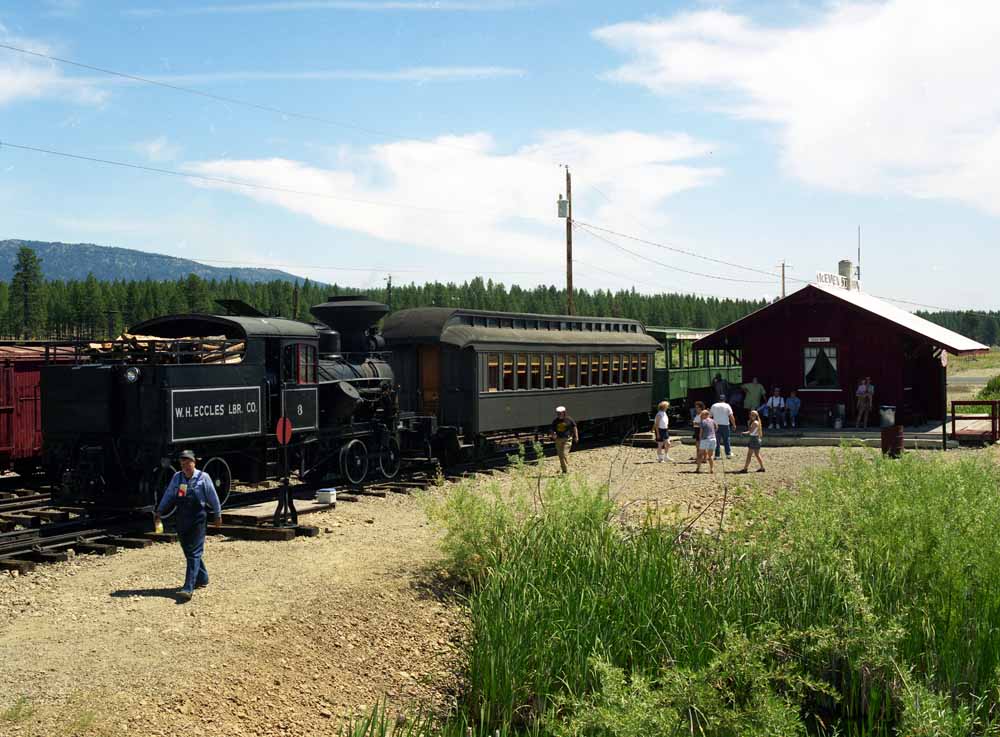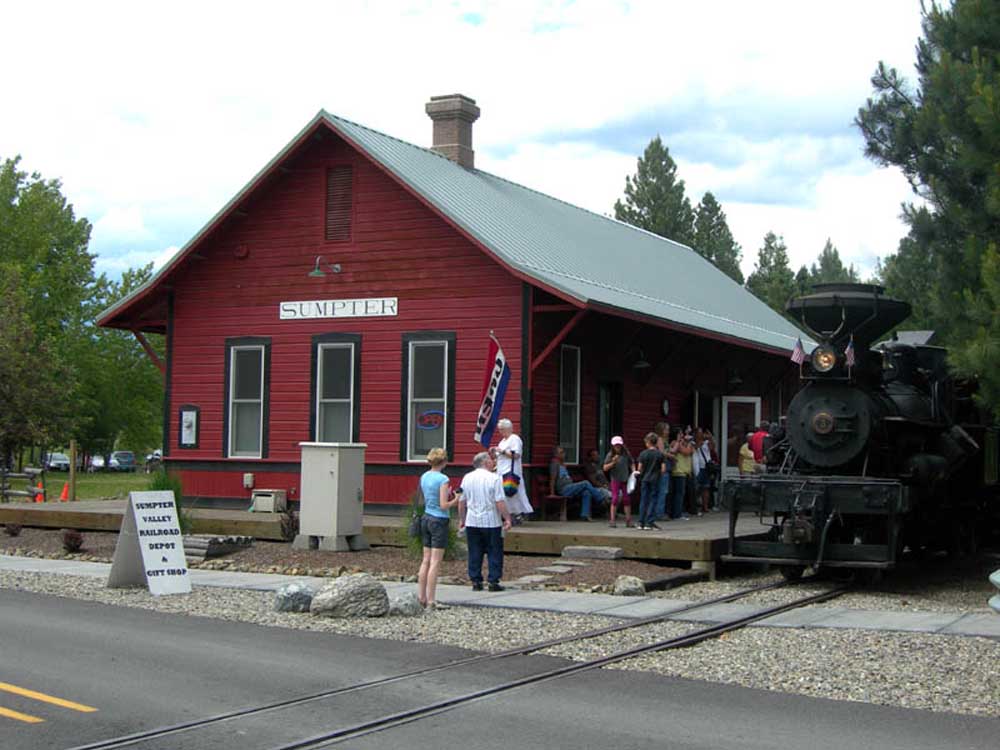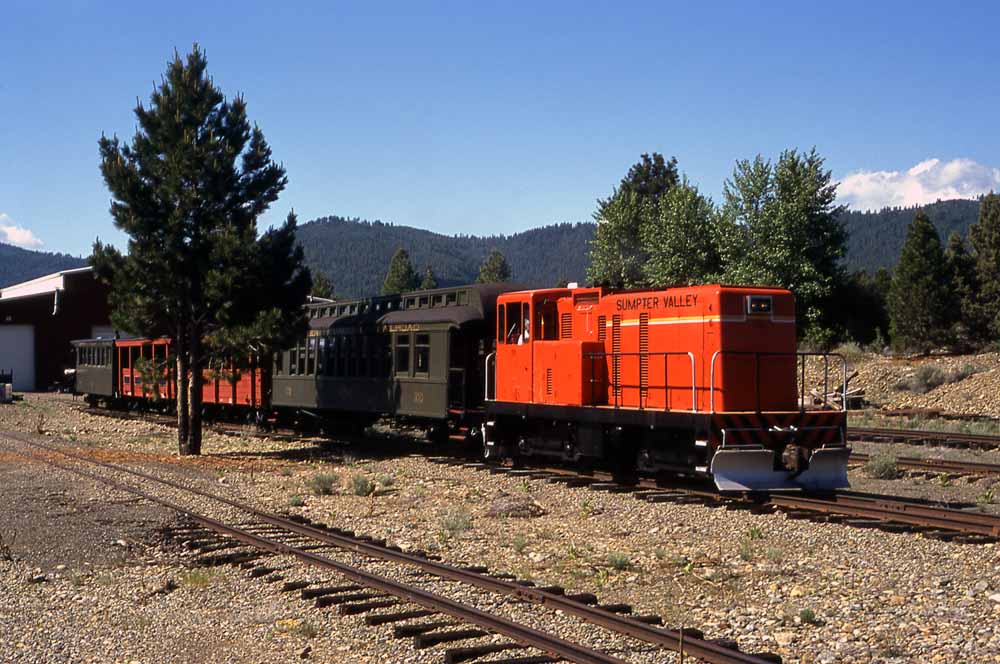|
Sumpter Valley Railway History 1971-Present |
|
|
|
|
In the late 1960's, a man named Nils Christensen started organizing efforts at rebuilding a portion of the old Sumpter Valley Railway. He found a small but receptive group of others interested in the project, and on 4 January 1971 the group incorporated the Sumpter Valley Railroad Restoration as a non-profit organization. The group started out on many fronts, including laying the groundwork for rebuilding a portion of the line and searching for suitable equipment, especially any surviving Sumpter Valley equipment. The equipment search hit pay dirt almost immediately, with several original Sumpter Valley cars located and conveyed to the organization. The big find came in 1971, when Boise Cascade announced it had a two-truck Heisler locomotive originally belonging to the W.H. Eccles Lumber Company available for sale at their mill in Cascade, Idaho. The group immediately purchased the locomotive, and Union Pacific donated transporting it back to Baker City. The group set up a restoration shop in Baker City and started rebuilding the locomotive. Meanwhile, efforts at laying track got underway. Edward Hines Lumber Company still owned the original Sumpter Valley right-of-way from the old McEwan station north to Sumpter and agreed to lease it to the group. Union Pacific donated ties and rails to the effort. Volunteer bulldozers went to work in the spring of 1975, both leveling off the old roadbed and blading out pads for the proposed depot and other facilities at the old McEwan townsite. The group completed a small depot building over the following winter, and track laying commenced by the spring of 1976. The group had two miles completed by the time the Heisler arrived on the back of a truck in June 1976. Edward Hines donated an old Oregon Lumber Company water tank that had been rotting away at Bates since the railroad closed, and a unit of the National Guard helped move the tank to McEwan and set it up. Several years of hard work paid off with an official ribbon cutting ceremony held at McEwan on 4 July 1976. The Heisler #3 went to work hauling passengers in two excursion cars over the quarter mile of track ready for service. The line expanded quickly, reaching Highway 7 by 1982. The permitting process associated with crossing the state highway held construction up for a while, with the highway crossed by 1986. Further construction brought the line close to Sumpter, where progress halted while the group worked through the various permit and other issues associated with building into Sumpter. |
|
 Heisler #3 preparing to depart the McEwan depot with another passenger train. John Henderson photograph, Jeff Moore collection. |
|
|
Meanwhile, the search for additional equipment continued. Sumpter Valley caboose #5 came back from the
Eastern Oregon museum in Haines, OR. The two articulated locomotives became available in South America, but
the group could not raise cash fast enough to save them from the scrapper. The group did, however, get the
two tenders from the locomotives, which had originally come off other Sumpter Valley steam locomotives. In
1976, the group found original Sumpter Valley steam locomotives #19 and #20 on the White Pass & Yukon
railroad dead line in Alaska and raised enough money to purchase the pair and transport them to McEwan. Donations continued to roll into the project. Union Pacific provided rails and track materials from two branchline abandonments in Oregon, specifically the Vale-Brogan and Weston-Athena branches. Crown Zellerbach donated a small diesel locomotive and some rolling stock from an in-plant switching railroad at a sawmill that company owned in Camas, Washington. Members of the David Eccles family learned of the project and made substantial donations to the group, allowing it to pursue additional aquisition, expansion, and restoration efforts. And, finally, the Edward Hines Lumber Company deeded the right-of-way over to the restoration group. The railroad finally realized its short term goal of returning to Sumpter in 1991. Development in Sumpter since the original railroad quit obliterated the last part of the original grade into town, which forced the restoration group to develop their own. The group obtained the final parcels of land needed for the right-of-way in 1990, and the first train back into Sumpter operated on 27 April 1991. Heisler #3 and the small diesel handled all operations through the first two decades of the new Sumpter Valley's operations. In 1992, the group secured enough grant money to make restoring one of the repatriated mikados feasible, and the #19 departed on a truck bound for the Daylight Locomotive Works in Portland, Oregon. Restoration of the #19 consumed four years and a quarter million dollars. The debut of the #19 in July 1996 gave the railroad two functional steam locomotives with which to power operations. The group at the same time completed a large and well equipped shop building to provide space to house, restore, and maintain equipment, which has grown to include equipment from narrow gauge operations all over the north American continent. |
|
 Heisler #3 at the Sumpter Depot between runs. Jeff Moore photograph. |
|
|
While the railroad has attained its immediate goals set when it started operations, there are additional
expansion plans on the table. The most immediate plan is to construct a balloon track at Sumpter to turn
trains at that end of the line; however, the line would cross through an Oregon State Park land that
preserves an old gold dredge and other mining industry relics, and the sensitivities associate with
crossing the park land and bridging the various waterways is making this extension a difficult proposition
to get through the permitting phase. At the other end of the line, the U.S. Forest Service has been in
discussions with the group about continuing on the old right-of-way east from McEwan to the popular Union
Creek campground and recreational areas. While a portion of the original grade could be used, the majority
of this extension would require new construction due to a dam and reservoir that inundates the original
alignment. The group has also discussed at various times continuing on up the original grade from Sumpter
towards Larch Summit, with at least one ambitious plan from the mid-1990's calling for the line to be rebuilt
all the way to Whitney with a return loop back to Curry constructed over old logging railroad grades and
a certain amount of new construction. The railroad currently maintains weekend and holiday operations through most of the spring, summer, and early fall months. Trains currently operate twice each operating day from McEwan to Sumpter and back, with additional trips added during major holiday weekends. Sumpter is now a quiet tourist town, boasting about 250 residents and a good number of tourist venues that can be visited between train rides, including the partially restored gold dredge. Enough freight equipment is on hand to allow the group to run chartered photo freights and other specials for various parties. The group continues to acquire appropriate narrow gauge equipment as it becomes available. All operations and maintenance on the railroad continue to be done by an all-volunteer work force. The line is definately worth spending some time to see and ride, and several other traces of the Sumpter Valley Railway can still be found, including the grades south and west of Sumpter and the Prairie City depot, which has now been converted to a museum.
|
 Sumpter Valley #720 switching a passenger consist outside the shop. Keith E. Ardinger photo. |
|
|
|